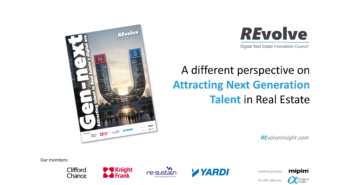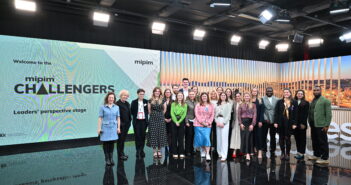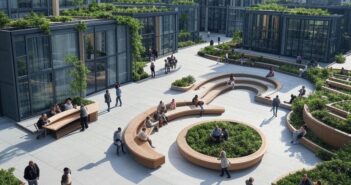In the third of a new series of blogs discussing Schneider Electric’s approach to Responsible and Responsive real estate, we talk to Marcus Moufarrige of Ility and Andrew Loudon of Sidara about the benefits of robust operations
Businesses which think outside the box when it comes to organising operations can steal a march on the competition, recent case studies show. And the benefits are even more impressive when firms can automate such processes across buildings, operations and people.
Marcus Moufarrige, founder and CEO of operational efficiency specialists, Ility says: “The way buildings are run has changed so much. Today landlords are focused a lot more on the building’s financial performance because they’re worried about its valuation, as opposed to the actual operations and the revenue that’s coming from the tenants. As a result, they often outsource that part of the business to third parties.”
In order to tackle that, you really need automation – it’s not just a nice to have at this point, it’s a must have – Marcus Moufarrige
However, these third parties need to be highly specialised to tackle the complexities of everything from ESG to F&B, or simply trying to create an environment that attracts employees, incorporating flexibility, services, amenities and more, Marcus says. “In order to tackle that, you really need automation – it’s not just a nice to have at this point, it’s a must have. From my experience, automation in a multi-tenant environment really drives profitability. It makes an amazing difference, and we’re showing that already with some of our customer results.”
Adds Brett Spindler, global director enterprise software, Schneider Electric: “The more manual a company’s processes are, the more expensive it is and more open to failure you are. If you can automate something, your speed of transaction, your predictability of delivery and your cost of delivery all radically change.” However, he warns that some operational improvement technologies just create more to do, by prompting a plethora of recommendations. “Instead, we want to create self-healing or autonomous buildings. If I can enable a property to understand how it is operating, how it should operate, then the building can look at what’s happening, determine what is to be done, and take the action.”
Brett explains that one of Schneider Electric’s priorities with interior architecture is making sure the business, the people and the operations all benefit from the application of technology.
When this works, Marcus notes that “you not only reduce costs, but also the need for people to do a lot of manual and mundane tasks. That means they can have a better work experience than entering data into a report.” He underlines that the benefits are “not just about removing friction – but about removing bad friction and enhancing good friction.”
Marcus explains: “Good friction is creating an environment where you can get your employees to be in the right place at the right time to create productive friction. And bad friction is anything that gets in the way of that.”
Sidara is another firm exploring the benefits of smart buildings for better operations – this time for its own processes. The 20,000-strong design management and consulting firm recently collaborated with Schneider Electric on its new UK headquarters. Sidara UK managing director Andrew Loudon explains: “We developed a new, multi-million-pound building in the centre of London – we were uniquely placed as the developer, owner, and designer of the building. The vision behind the project was to create a place that bringsall our brands together under one roof for the first time, and exploring what that could bring.”
For the project, Sidara used Schneider Electric technology, from intelligent energy management systems, all the way through operational systems and building systems. “That means from a performance perspective, and a people perspective, that we can generate a lot of interesting data and information,” Andrew notes.
The space is all about collaboration, understanding how people work and interact together, and encouraging firms to come together – Andrew Loudon
The resulting building has created synergies for the firm in terms of creativity and productivity, as well as driving cost savings, Andrew says. “The space is all about collaboration, understanding how people work and interact together, and encouraging firms to come together. We have an atrium with a staircase that links all the floors, and we wanted to encourage the different teams to work together without forcing them. Data shows us that that interaction is happening.”
He adds: “When we started out, we took a kind of blue-sky approach to think about how technology could help us operate better. As a consulting firm, we wanted something different, so our clients and customers could see all this when they come to visit. So we decided to push the boundaries of what we could do.”
The results were surprising at times. “What has been interesting in the first year is being able to truly look at how the space is being used, thanks to data,” he adds. “We were developing the building during the pandemic, so we were trying to understand how to attract people back to the office. Surprisingly, we saw that people were coming back very quickly. Partly, this was due to the appeal of a nice new environment, with high air quality, daylight and connectivity, but we also learned other things about building use.”
Andrew notes that Sidara will probably retrofit some spaces over the next year after looking at usage patterns. “Meeting rooms aren’t being used efficiently,” he notes. “Client floor rooms are being used 70% of the time with just three or four people in them. So, thanks to the data, we will probably repurpose some of that space to use with greater intensity and make it more fit for purpose.” He adds: “We also decided to not open the restaurant on Fridays, after seeing footfall data.”
In conclusion, Andrew says: “It was so important for us to get a lot of young people back into the building post-Covid. Young people need to be mentored at the early stages in their career. We also now have an asset to attract talent, and even involved younger people in making decisions about how to put the building together.
“We have lab type incubation spaces in the building and a lot of customers are keen to come in and use that space, even if they aren’t meeting with us. And we have set up a digital advisory business within the firm to offer consulting for other firms on this kind of project.”
Schneider Electric: Enabling Responsible and Responsive Real Estate
The real estate sector faces the urgent challenge of minimising its carbon footprint to comply with government regulations, reduce operational costs, and satisfy the evolving needs of occupants and stakeholders. Download our eGuide to explore how our solutions deliver real impact for our customers across key focus areas: sustainability acceleration, energy management, asset performance and operations, user experience and portfolio strategy. Find out more about Schneider Electric here.



